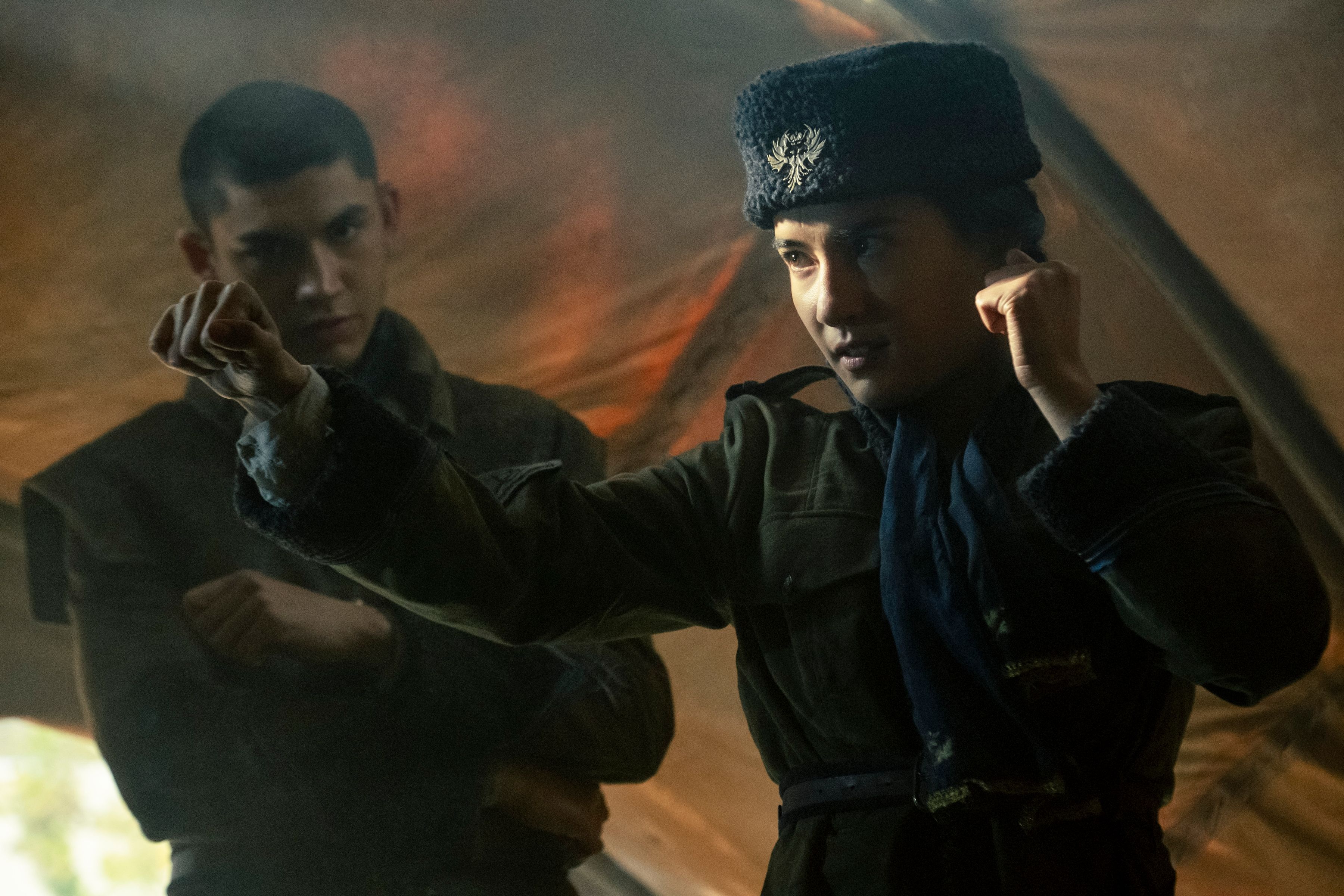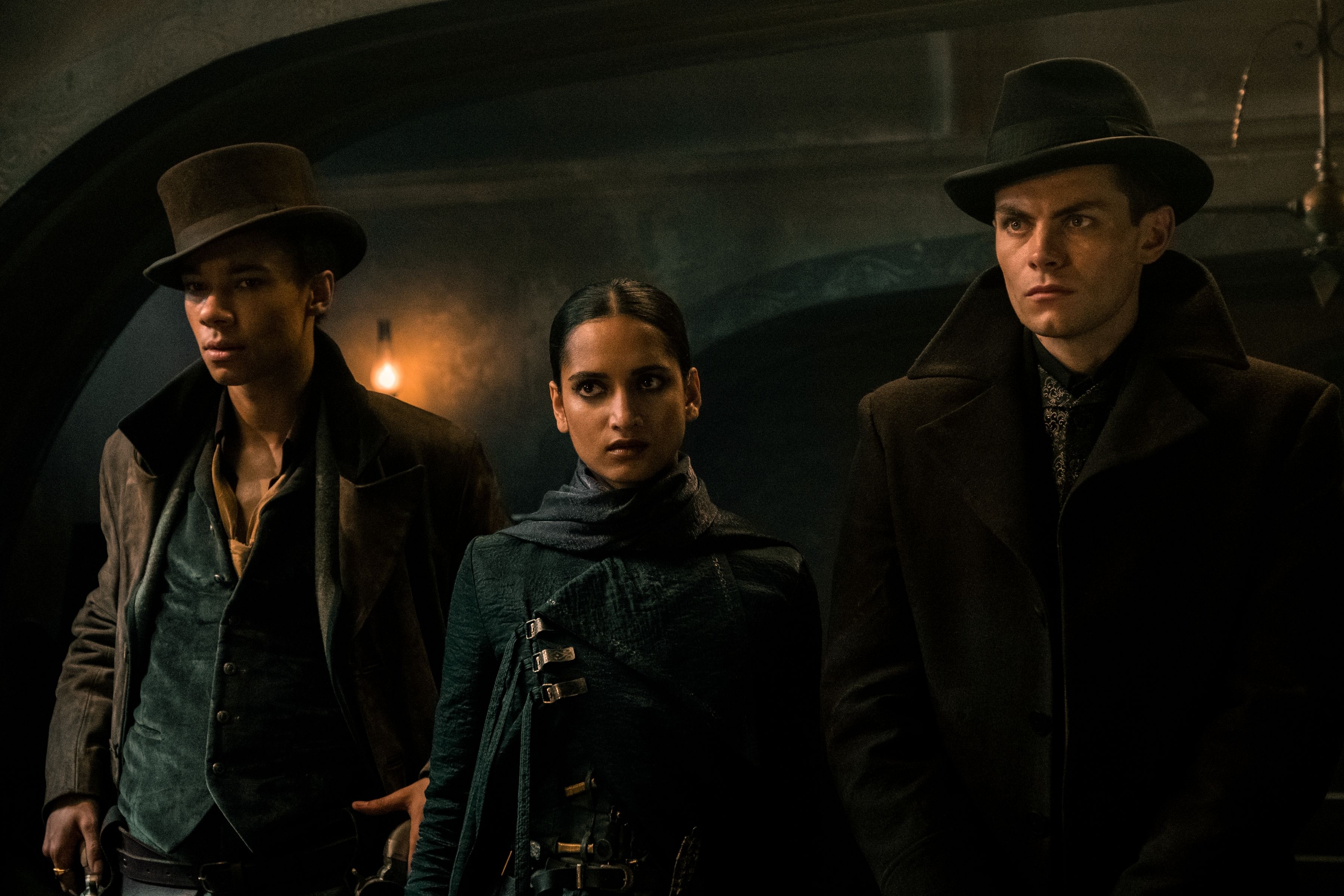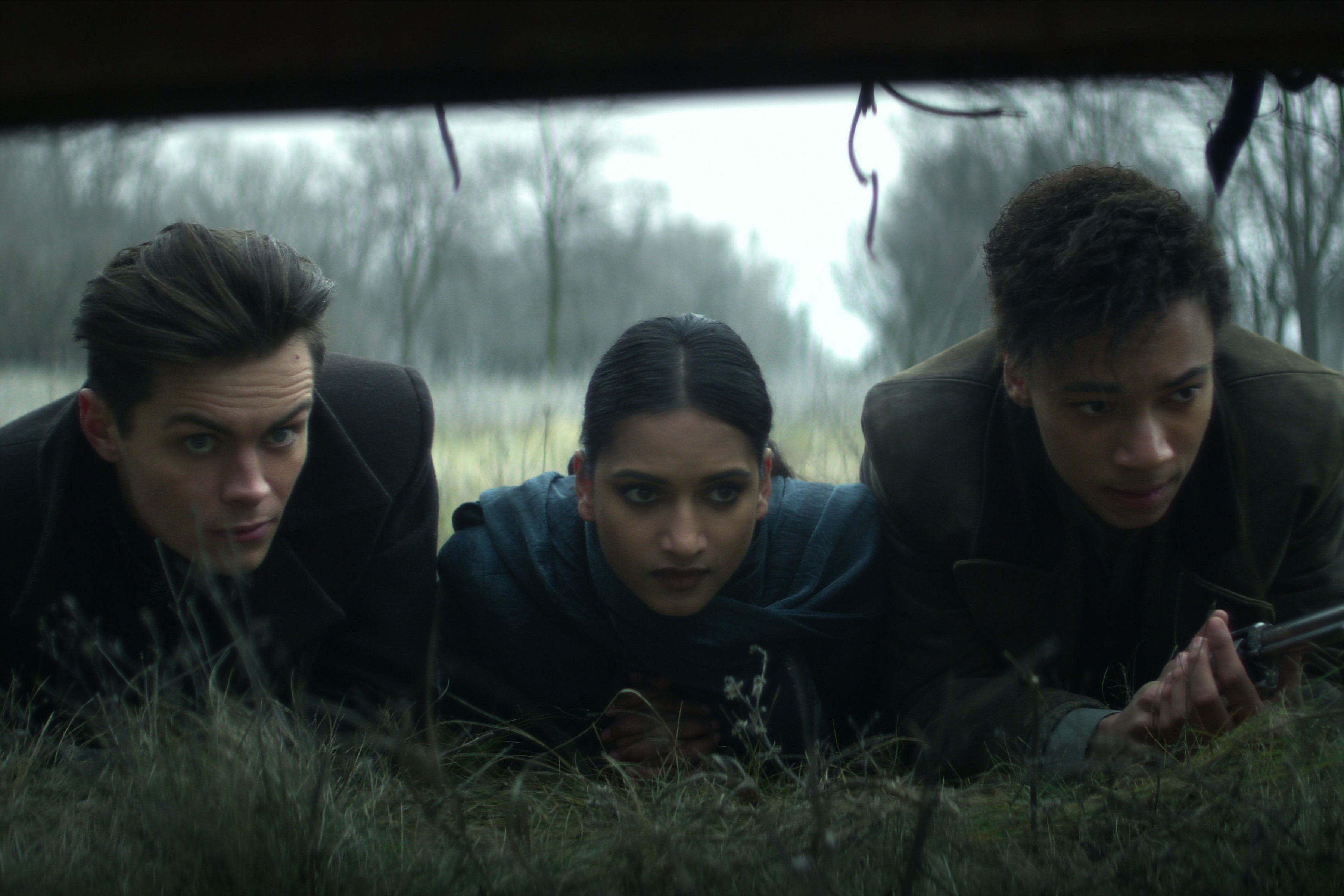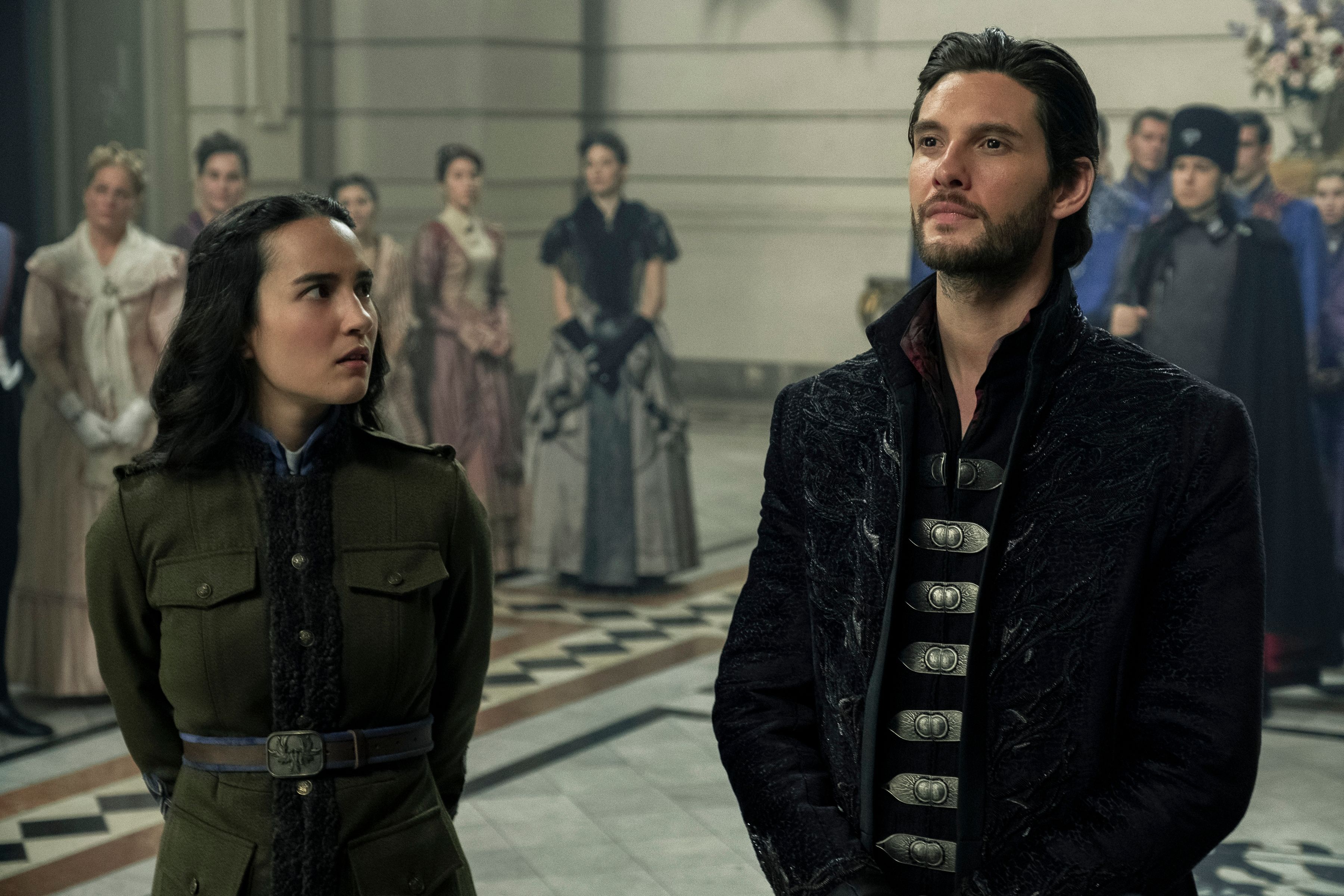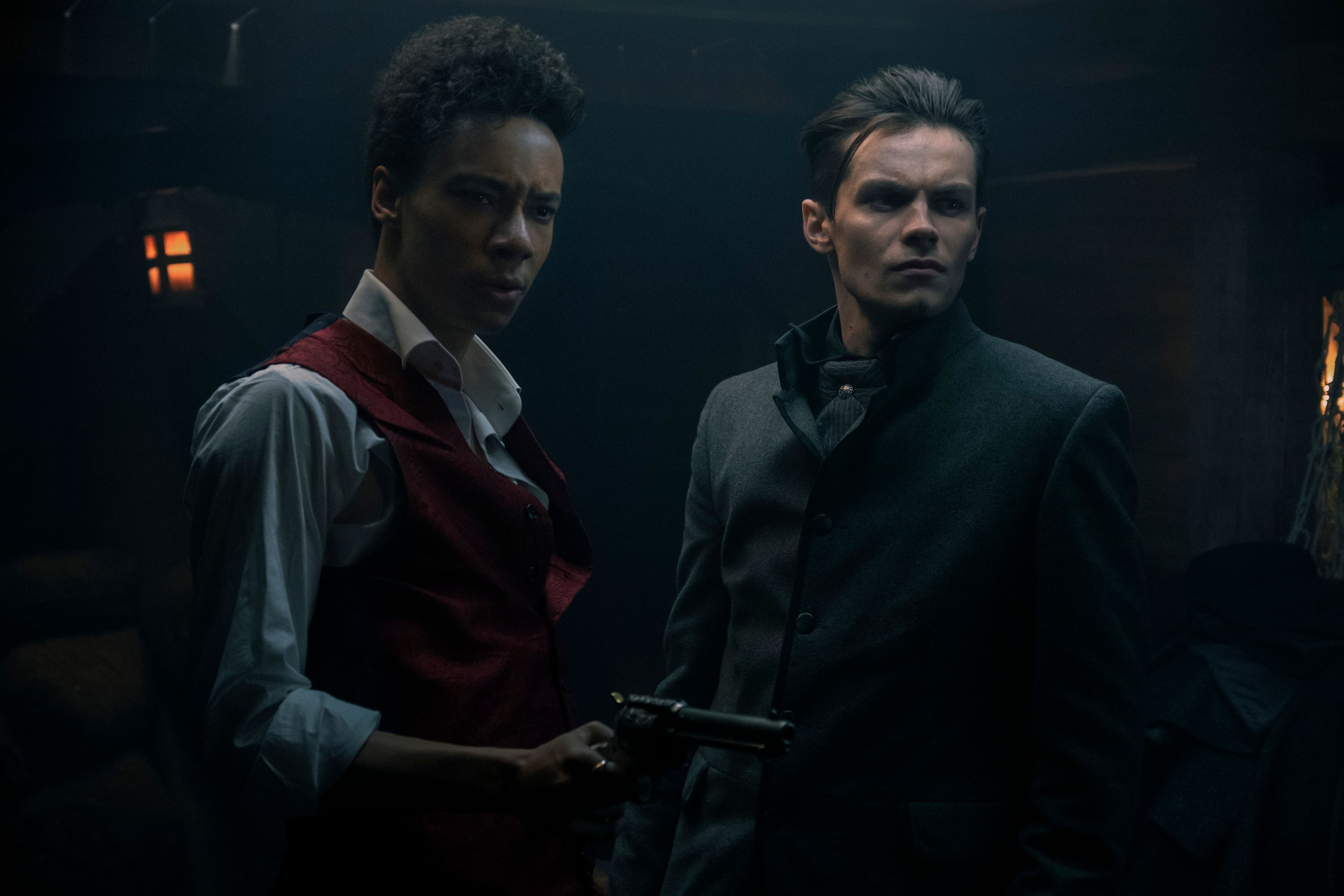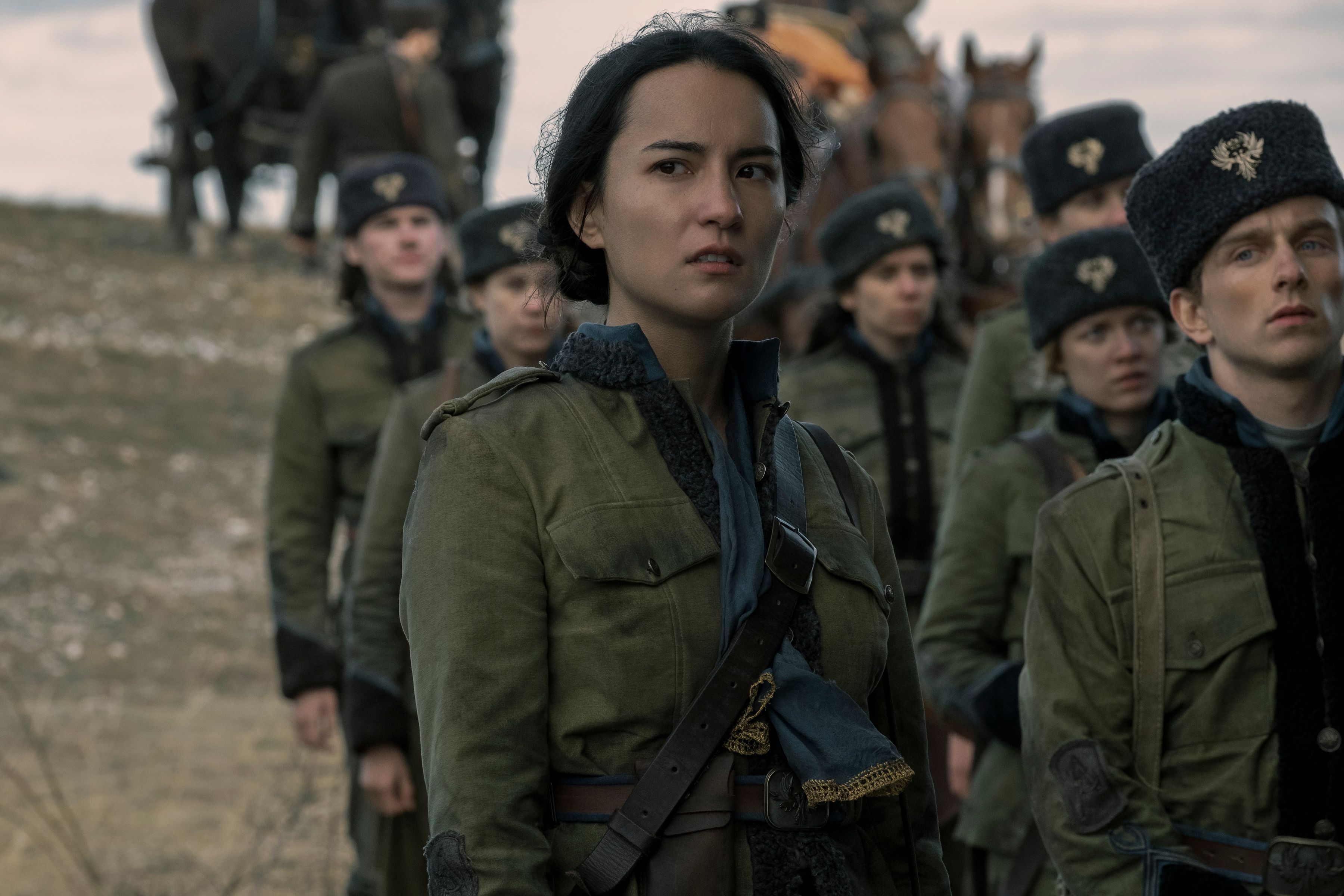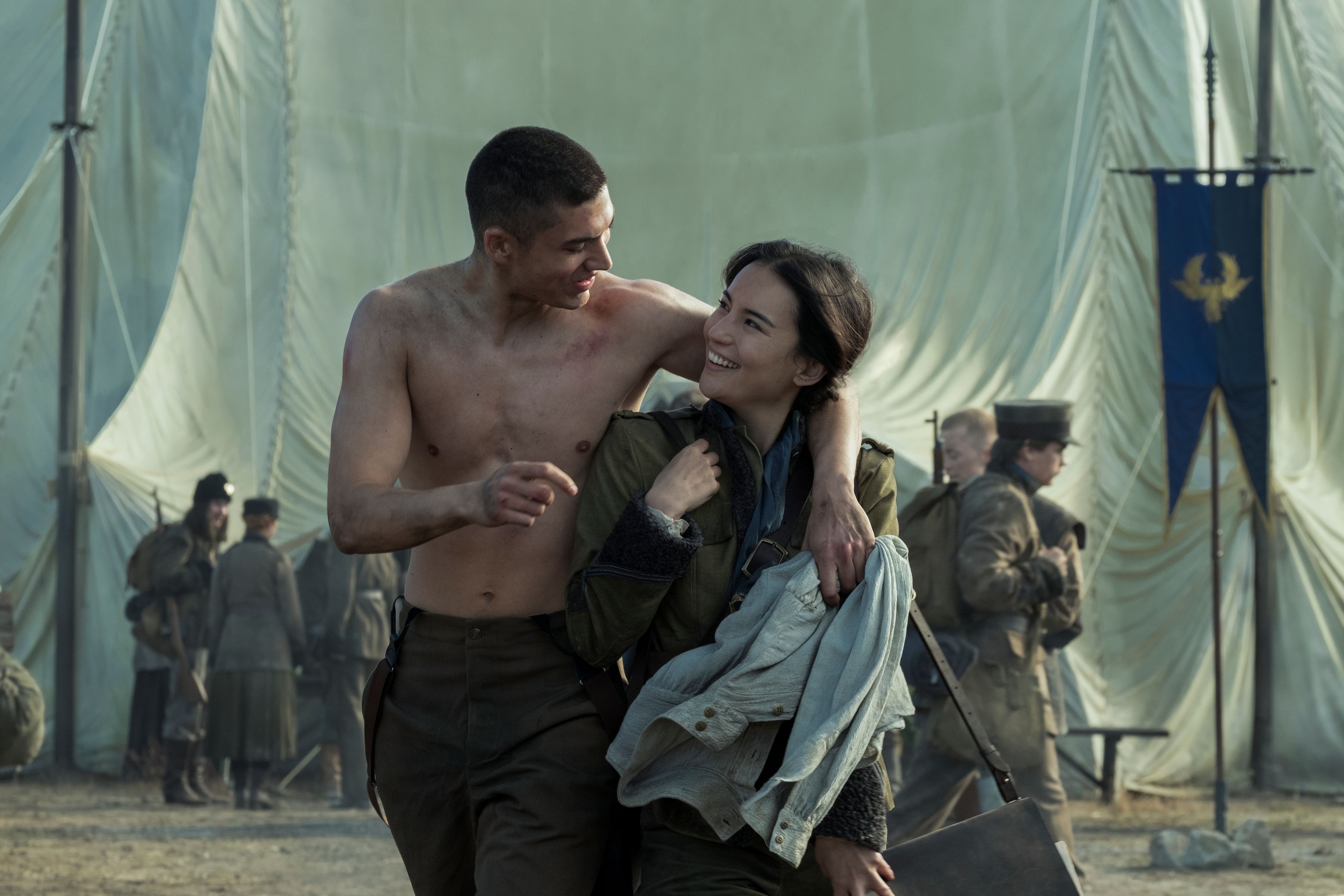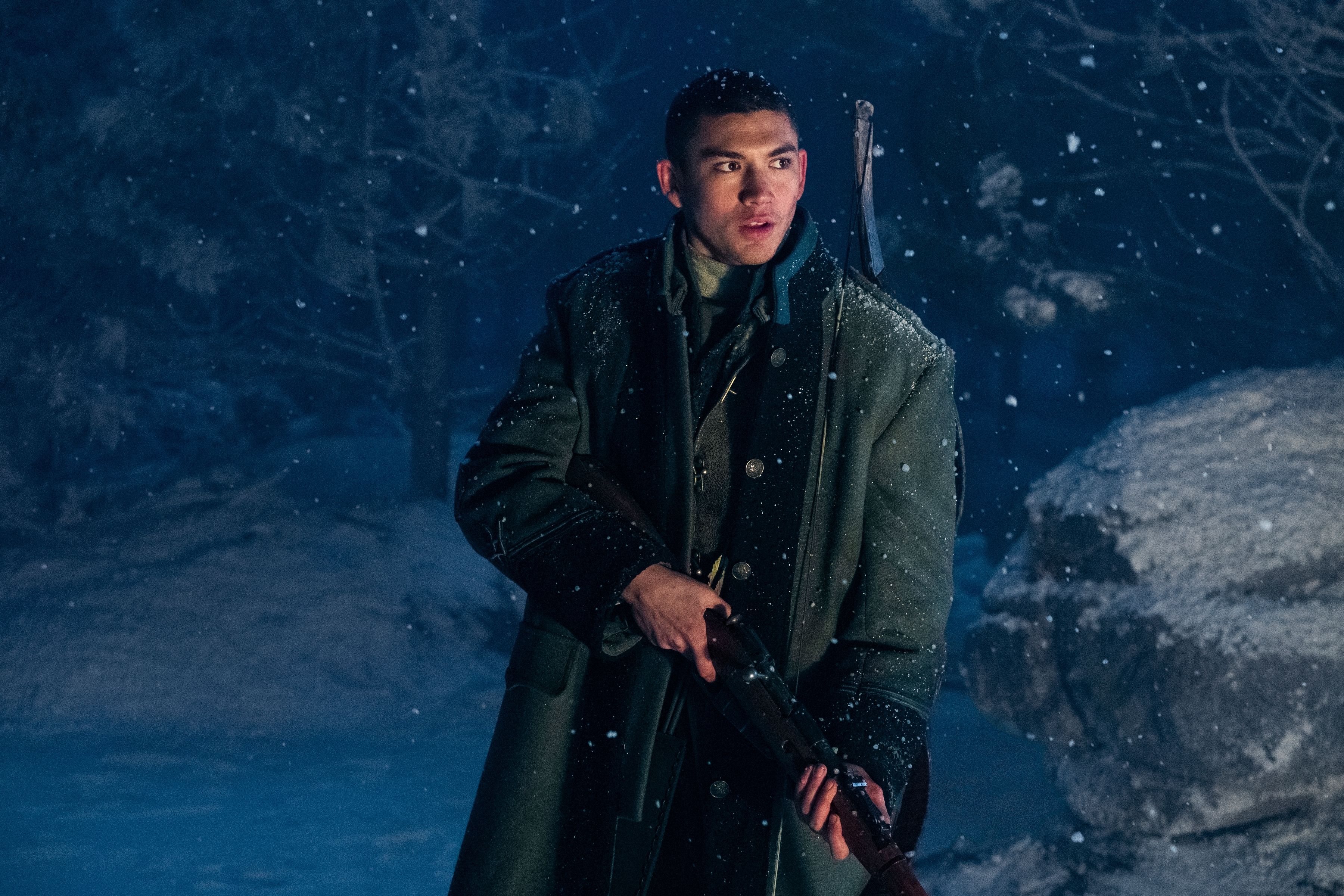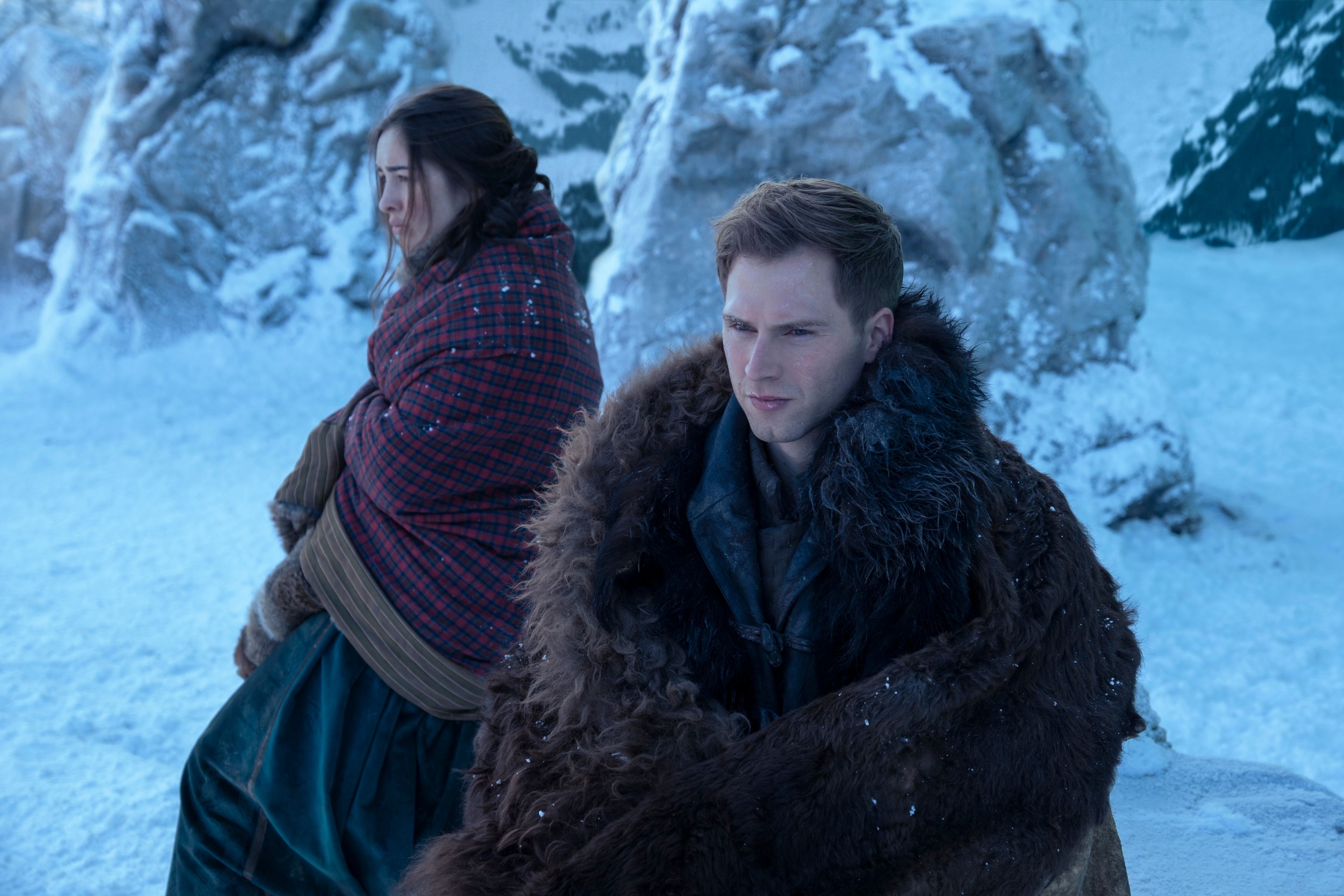While it’s always great to talk with actors about the making of a series, if you want to find out how and why the big decisions were made, you need to speak with the showrunner. After all, the showrunner is the one that is directly involved in every aspect of the production — from casting, writing, picking directors, working with the studio on budgets, deciding storylines, and so much more.
Last year, when Shadow and Bone was filming in Budapest, I got to visit the production with a few other reporters. While there, I got to witness first-hand how much time, effort, and money was being poured into making author Leigh Bardugo’s world come to life, and I left the set thinking Shadow and Bone could be a very cool show that had appeal far beyond its YA book fanbase.
If you’re not familiar with Shadow and Bone, the series takes place in a war-torn world where a lowly soldier and orphan named Alina Starkov (Jessie Mei Li) accidentally unleashes an extraordinary power that’s been residing in her which could help save her land and set her country free. What you also need to know about Shadow and Bone is this world has magical soldiers known as Grisha that have different powers, and a massive black cloud (known as the Shadow Fold) that runs hundreds of miles north and south and is extremely dangerous to cross due to the creatures inside.
The series actually combines two of Bardugo’s book series – the fantasy-adventure trilogy Shadow and Bone and the duology Six of Crows, which chronologically takes place after the events of Shadow and Bone despite being set in the same world. Heisserer said that, in order to make this work, they essentially invented prequel stories for the key Six of Crows characters this season — Kaz, Inej, and Jesper — to fit alongside what is happening in the Shadow and Bone storyline.
During a break in filming, I got to participate in a group interview with showrunner Eric Heisserer. During the extended interview, Heisserer shared a ton of information about how they combined Six of Crows with Shadow and Bone and why they did it, what the series is about, why he embraces the YA name, what made him want to adapt this series, how he got the job through Twitter, his future plans for the series, if the series will have queer representation, how they cast the show, why it’s eight episodes, and more. In addition, he teased a possible a faceoff between Kaz Brekker and The Darkling…
Check out what he had to say below. Shadow and Bone starts streaming on Netflix April 23rd.
QUESTION: So first the most obvious question, merging these two novels into one, how do you go about doing that, especially considering the chronology of the series?
ERIC HEISSERER: Very carefully. And, you know, it required building some story, a prequel worth of story for most of the characters, so that we don't break anything in Leigh Bardugo's timeline. I had her on speed dial and there was a lot of me calling, “So what about this.” She's like, “No, cuz then so and so,” okay right.
Sorry, just to clarify, are we not getting into the story at Six of Crows quite yet. Are we mainly building those characters' back stories?
HEISSERER: Well, it's interesting the way that Six of Crows is built in that you do get into back stories that are outside of the current timeline. And so we touch on some of that for a few of the characters, and for others, it's brand new.
For anybody who hasn't read the books, where do we start and what kind of journey are we going on?
HEISSERER: Sure, absolutely. I mean, you have a pretty big world in this space. And so we put you on two different tracks really. One is a sort of a grand sweeping Russian-inspired mythology of a First Army [soldier] who's mixed race, and one half of her is from what they consider one of the enemies of Ravka. So she's kind of got a tough gig right out the gate. And then it turns out that she has an ability that can save the entire country. And what does that [do to the] inherent prejudices against her, and how sometimes can she use that to her advantage. Spending a young lifetime trying to blend in and be in the background and not be noticed, and suddenly being in the spotlight 24/7, what can that do to a young woman who's suddenly the most important person in the entire country.
Then you have another set of characters who are criminals. The I would say, Ocean's 11 via Charles Dickens. And how these scrappy people get involved in the big sweeping drama that's happening on the other side of the Shadow Fold, which is probably the most iconic landmark in this world. You know, if we were to pick something that is unique to the Grisha verse it's the Shadow Fold, which is this giant scar that splits the country of Ravka in two and is slowly killing off a good portion.
What are some of the elements of the book that you're really proud of being able to pull off in live action, sometimes those things are difficult to translate.
HEISSERER: Yeah, sure. I mean there's, there's a lot that's difficult to translate, but certainly I think the Fold, if it comes off the way I want it to, will look really cool and different. We're playing a lot with cinematographically how to express that and make it feel otherworldly.
And, you know, we have Joe Trapanese as the composer, who's good and he's got a breadth of score work that allows us to do something that you know needs Russian and big and sweeping in one area, and otherworldly in another. It's a buffet for him.
I'm curious what it was about this material that pulled you in and said I want to take point; I want to make this?
HEISSERER: Well I think there are two questions that I found present in both series that get expressed differently in every character, and so you get into sort of like a spectrum of exploration of these questions. The first is where do I belong. And the second is what is within my power. And what I found so compelling about those questions is they're ones I see myself and other people around me asking right now in the world. And it's typically when you feel like there's an overwhelming force against you or the cards are stacked against you. And for each of our characters in one way or another that's the case for our heroes at least.
Leigh had mentioned that the Shadow & Bone first series was very straight very white and with Six of Crows she tried to show there are all kinds of people, different backgrounds and sexualities and whatnot. And it seems like by merging these two books, what sort of things from that standpoint, in terms of showing more diverse world were important to you to bring to the series?
HEISSERER: I think it was part of the reason why Leigh and I were excited about making Alina, the lead, half Shu, because then we already stepped out with something that was different. We liked the idea that the way she bonded with Mal is that both of them were mixed, and that just carved out a different space for us in the adaptation. Then we were all excited about landing at the Little Palace, which is the place where anyone who's discovered to be Grisha will go. Like if this were an X-Men comic it's like, “Oh you're a mutant, now you're going to go now to Xavier's and this is sort of like the Xavier School of this.”' I'm talking to the one guy I know hasn't read the books.
Anyone can get tested no matter what country they're in, no matter who they are, what color their skin is. And once you land there it goes from like sort of white Ravka prejudice into “Oh, this is a really interesting melting pot.” And they got money now, because obviously that's where the research and funds go.
When you're pitching something like this to Netflix are you laying out a three- or five-year arc?
HEISSERER: It was a very early conversation, and it was a three-year plan that I laid out, or three season plan, or however long that would take at this rate of three year production scheduled like it'd kill me to do all those seasons. So, I want to back it off a notch so that I can survive to see it but. But I did go in like...and it came about in a really interesting way because it all came from a new year's resolution that I had three years ago, which was to do more pleasure reading. I just wasn't doing enough of it, and there's something about when you're reading for work, you always have that part of your brain on, like, “Ooh can this be adapted or…” And I'm like, I just want to have fun.
And so I reached out to one of my friends from Oklahoma, who has nothing to do with the business, who I trust implicitly, and I'm like, “Give me something cool read,” and he's like, “I got your number.” So my way in was Six of Crows, that was the first [Leigh] Bardugo Grisha first book I ever read. I just ate it up.
What I've done as a practice is when I consume something that I love, whether it's music or movies or TV or books or whatever the comic books, I then go find the creators, the artists that are behind that and just on social media, engage them, and say, “Thank you, this was phenomenal, I had such a good time.” Because I see the ratio of good to bad feedback that any artist gets is pretty depressing. So I'm trying my best to help even out a little bit.
And then it was a year later, that I got a call out of the blue from Netflix and they said hey, “We know you tweeted the author a year ago.” You know, so I got past like the Big Brother paranoia and Leigh just remembered that. It really stuck with her. And she's like, “Well, we can get the guy who wrote Arrival maybe, you know, cuz he likes it.” And I went in with this big plan, and midway through the first meeting, they stopped me and said, “Oh it's nice that you have grand designs, but we only have the rights to Shadow and Bone, you don't have Six of Crows” and I said, “Well, that's it for me” and I just walked right out.
And part of the reason why I think I was just so arrogant at that point was that I thought that I had another job lined up. And then, as I'm driving out of the parking garage, the phone rang and my agent was like, “So that thing just fell through, so hopefully your Netflix meeting went welL” and I was, “Noo, why did I swagger.”
But sure enough, two months later, Netflix called and said, “All right we got the rights to the whole thing now so let's go and see if we can crack this.” And then we were off to the races.
What was your original idea? Is it what we ended up with?
HEISSERER: Thankfully it was. Yeah.
Can you explain why you decided to combine the two because they're almost like two different genres of stories.
HEISSERER: They are, and I think it's because I love both for different reasons, and they live in the same world. I think if you just do one you're getting a smaller slice of your audience. I'm essentially making a show where people are gonna be like, “I don't like this character, but I love these two.” And I'm alright with that.
So is it going to be kind of like Game of Thrones in the sense that every character gets their own point of view story, because on Shadow and Bone it's all through like Alina's eyes.
HEISSERER: I've been told it for the most part, I should smile and nod when anyone says it should be like Game of Thrones. But, but no it required some rework of the Shadow and Bone piece in order for that to handshake well with Six of Crows so that Alina just becomes one of many POVs that we get to enjoy in that side of the story.
This is eight episodes. Was it always designed as eight?
HEISSERER: No, it was designed as 10. So, we have done what I've seen my wife do with luggage which is we packed 10-episode stuff into 8.
Netflix has been producing a lot of eight-episode series. And so I guess that must have been a note from Netflix saying we're having success with eight.
HEISSERER: It was very gentle from them. It was like, you can absolutely do 10, [but] you're going to get the same amount of money. So, do you want to spend more and get better production value if you do with eight? And my answer was yes. Yeah, I do. Because we got a lot of really big world building to do.
Have you seen any of the small science effects brought to life yet?
HEISSERER: We're in early stages on that. I've seen a lot of stuff that I've said no to so far, but I mean we're getting closer. The small science stuff is one of the more--
That's the powers, FYI--
HEISSERER: --graspable, I mean, yeah, the Inferni and the Squalor and that kind of stuff, a good deal of that is practical so we were already there for a lot of them. You know, it's the sound design that is communicating things that are a little bit more ephemeral, like harmony.
There’s a lot of YA elements in these stories but it's also very dark and very violent sometimes. How are you sort of balancing is this a young adult straight up story or are you going more mature? How are you creating the tone?
HEISSERER: It still has plenty of YA elements to it, in part because it kind of breaks my heart that that is used as a derogatory term in some circles. I feel it's unfair. It's really, you know, considering the audience that show up to those, the audience is far older and it's the same reason that I have an allergic reaction to "guilty pleasure," like no, just enjoy it and just be proud of enjoying whatever you like. So that I fully embrace.
But also there's a darkness to these books that I want to make sure I didn't lose because then I would be betraying what it is that Bardugo made. And at the onset, I am borrowing the keys to her car. This is her world. And I am honored to be someone who can bring it into another medium. But this is just the Leigh Bardugo verse that I'm doing my best to represent.
RELATED: ‘Shadow and Bone’s Jessie Mei Li and Sujaya Dasgupta on the Diversity of the Netflix Series
What has Budapest been able to provide to the production that maybe some other places couldn't. And was it always going to be Budapest
HEISSERER: I mean, we certainly looked at other locations, but the best value for our money was here in Budapest. That was just...our production rates, and the artists and the craftsmanship, especially on the set design side of things, great production teams. The crews here are good. It's a magic space right now, where we are far enough east into Europe that rates are quite affordable, and you get your hard workers. But we're far enough west that, you don't worry about something just something falling apart. But they aren't so proud of themselves, that you know, you're getting L.A. prices for things that's I guess the best way to put it. Where it's like you get great work and you can afford it. And hopefully, we can make something look like it was three times that amount, without being exploitative because that's not the case.
We've heard you filmed outside of the sound stages here in Budapest. Can you talk about some of the places you filmed and what you know what you've been able to use practically?
HEISSERER: Well, you know, we found a castle or palace location, I don't know that it's formerly a castle, but I think somebody used that at some point in time to describe it. And it's a campus that has a great feel for that we shot a lot of our Little Palace stuff on including the Winter Fete, and some are more complicated sequences from the Shadows and Bone book. We did some backlog building to preexisting structures to build a really interesting looking Ketterdam for our Six of Crows. And then we built a lot. We had to invent Sandskiffs for this, because those are the vehicles that cross the Fold. Now we have a giant skiff that's parked in the soundstage over here. We had to pick the stage because it was the biggest in Hungary, and it was the only one that could fit the thing. So, there's a lot of value for your money there too.
Some of the queer representation takes a little bit of time to get there in Six of Crows. Can fans expect some of that early on in the series?
HEISSERER: Oh yeah.
Can you elaborate on that at all, especially since, one of the characters is not listed?
HEISSERER: Yeah we don't have Wylan in season one. No. But, I mean, but that doesn't mean Jesper doesn't get laid. And we also have a drag queen which may be a first in fantasy TV, I'm not sure.
Speaking about sort of the romantic storylines which are very prevalent in both series, how heavily do you lean on that considering you have to cover a lot of ground in a short number of episodes.
HEISSERER: We do our best to service the characters and just be right whenever we aren't with them and make sure that that gets expressed, and there is a lot to cover. I'm sure if the fans and I both had our way we would, you know we'd spent 20 episodes where we just go into the backstory of each of them and just like play that out. But for now we have to be content with the promise of more for each of them. And we've set up as many as we could and made sure that we get to, you know, Inej's family and her needs, and Kaz's long revenge plan, and the fact that, yes, we might eventually one day have some Kaelish action for Jesper. There was one like early costume idea of like, 'Do we at some point in time put him in a kilt, is that a thing? Should we play with that?'
And so all of those things, certainly are in place. And, as well as the rather difficult history of our villain.
When you're designing a kind of overarching story of the season, do you do this like one big eight-hour movie or do you kind of take an episodic approach?
HEISSERER: Well I'm married to a TV writer and one thing I learned from her is how important it is to make sure you're still telling a story in an episode. It can still be part of a larger tapestry, but you need to have something that's whether it's, you know, a minor adventure or an obstacle overcome, or you know whatever it is to be able to plant the flag and say this is the episode where this happens to this character, or where so and so grows and learn somethings or another. And there's another reason why I'm so excited about having the Crows on board because no matter what kind of long form story was playing out with Alina, in the Ravkan storyline, I have people who have something to heist every week, or have something of a con game or whatever the case it is. You know, an episode of Leverage baked into the larger season.
What MPAA rating would this get if they were giving it a rating?
HEISSERER: You know I've had a weird experience with MPAA ratings like horror movies where they like we saw some blood you're R like, “Why it's just some blood like you're really getting a problem with that?” But you know the show gets bloody, but I wouldn't consider an R rating.
So Matt did tell us that Alina is eventually on a boat with the rest of the Six of Crows characters. So the plot is essentially Shadow and Bone, but the Six of Crows characters come in around that plot?
HEISSERER: They bump into the plot. Yes.
What's really exciting there's a lot of newcomer actors and talent, so what was it like working with those new cast members?
HEISSERER: It's the best experience. Really, it's phenomenal. I mean, they're delightful. They're good human beings on top of being good actors so I really lucked out there. I'm grateful for them. And they love it. They've all read the books like which is a weird thing. “But of course they have” no, you don't understand plenty of times before, they don't. Some people don't do the reading but we're okay here, just let's make sure that nothing is blowing up.
What is the most exciting part about getting to introduce these characters to each other, because you're going to get to merge these stories and get to see interactions that we didn't get to see in the book.
HEISSERER: Well, I mean, come on, like, what's not to like, holy shit. Like, you think about, is there a moment with a faceoff between Kaz Brekker and The Darkling, do we have a fucking Batman v Superman moment in this thing? And who's gonna walk away from that? I don't know. So, I mean, and what would it be for Alina and Inej to meet? What would it be [like] for a woman who later names one of her knives after her? How does she get that knife? Why don't we talk about that. But I can't talk about it right now.
When, in the writing process when you're first putting this thing on paper. How much are you aware of the money you're going to be able to spend, and does that dictate any of the writing?
HEISSERER: Yeah, well I didn't want us hampered by that in the story construction of it, and I had to trust in the creative team at Netflix to be able to say “whoa, whoa pump the brakes there dude” at any point in time when I deliver it. Because you go through various iterations you do the story area, you do an outline, you sort of walk them through in a season pitch, where it's me and four bottles of water talking for 90 minutes straight. And then, you know, and then you get into the actual scripts that come. In this case, I made it sort of a must have to have all eight episodes written long before we were in production so we had a really good sense of like, what can we do, how much can we prepare for, what can we block shoot etc.
With that in mind you do get checks and balances, and sometimes those come later, when, after you've designed some part of the season, and the answers like, “Ah it turns out we really can't afford that. That's, how many skiffs are going? No we can't do it after all I'm sorry” but that's fine. There are absolutely moments that you get great creative solutions when you're feeling like you're Gary Sinise in Apollo 13, you're like, “How do I land this capsule with this much power” and so. I think we've figured out a lot of stuff out and still made it feel big without hampering a lot of the creative side of things. But I'd hate for us to start in that space. That's a problem-solving thing to get to, but I don't think you want to start there thinking like let's make the show kind of small, and maybe we get extra money later on. I don't know if that works.
Which directors did you get for the eight episodes?
HEISSERER: We got four directors, and each did a block so two episodes each. And we started off with Lee Toland Krieger who did the first block for us. And Dan Liu, he worked on episodes three and four. Mairzee Almas came in to do C block for five and six. And we’re right now with Jeremy Webb, who's finishing up the season.
Talk a little bit about getting these people and was it certain work that you had seen, was it Netflix presenting you with certain directors?
HEISSERER: For the most part, like, some of them I hadn't heard of before but some I had. And a lot of them just came as personal recommends from people in the TV business that I had grown to befriend and knew well, who I can trust and rely on. I got glowing recommendations from everybody. I wanted to pick people that I could trust on set on the day with a giant ass skiff, and a whole bunch of greenscreen and guys with sweepers on the sand trying to get rid of whatever footprints were just made like...I mean there's just a lot of giant elements here at play, and I wanted to make sure that I found directors who could manage that part of it fairly well, but never forget that it's all about like the performances of the actors the end of the day. Like I didn't want to have somebody who was just sort of the VFX guru, and then lived in video village and didn't really want to see or interact with the actors too much. I think that's so important. Because like at the end of the day, you're not like, “Man, that episode or that movie that one shot or blah blah.” No, it's like the line of dialogue that comes from the character that really hits you in the heart, so that's what I was looking for.
The fantastical has always been a great way to reflect the real world. In terms of the political landscape and the changes with Alina being half Shu, were you being mindful of that at all and like was that like, you know, part of the motivation? Did current issues impact your decisions?
HEISSERER: A great deal of that was motivated by the writing team that I put together for this. And I wanted to make sure that their voices were part of the construction of the show, and that things that meant a lot to them that they were either passionate or angry about, they could find a way to either use as catharsis and therapy and talk about through the platform. But it was organic to the process. It was the same reason why they got interested in Six of Crows in the first place or you know what they saw in Alina and those in those writers were very good about educating me. I think part of my job as showrunner is to be a student to the people around me and to find out what kind of message is more important to them. And just help them be the platform to launch that. So a lot of these things aren't things that I have personally experienced but I realized that they're very important to other people including minorities. Not a pure diaspora story but a story about mixed race, which goes in that question of where do I belong, was a real and crucial issue for a number of people on my staff.
As a casting question. When you're putting together this cast. There's a lot of fresh faces that we haven't seen before, but a couple that we do recognize. Were there any particular casting decisions that you've made on purpose? Can you talk about the casting process?
HEISSERER: It was an arduous process. Certainly. I came to it and we all come to it with the mental images in our head from reading the characters in the books. And then, beyond this it was trying to be mindful of the importance of representation of characters as well. I don't know, I guess I had this thought as the showrunner you're sort of like the Roman Emperor when it comes to like casting and all that stuff. Very early I got excited about Jessie for Alina and I said, “I found our Alina!” The answer was, “Okay so that's your vote.” And I'm like, “How many votes are there?” Probably around 14, everybody considered. Now and then I could like get two votes for a person, but it was very much a democratic process. And I think it's good for checks and balances so that like you don't end up sounding horribly skewed one way or the other. But, there were times when I got frustrated by that process, a bit. The positive thing is that I love everybody that we've got for this, and out of everyone we saw, the thousands of actors that auditioned for all the various parts, the people we have now behave the most like their characters. And that is, that is something I cling to.
Who was the toughest role that you had to cast? Was there one role that really got heated in terms of the 14 votes?
HEISSERER: There were more than one, but I would say the one that was most surprising to me was finding Mattias. Finding Mattias wound up being like, “Certainly we can find ourselves like a Nordic and handsome white guy,” no actually that was a really, why do they not make Scandinavian Hemsworths, I don't know. But it was really rough. It was really rough, finding someone who could land that right. Because there are ways that you bring someone in and they just play the role as Worf (from Star Trek: The Next Generation). And you're like oh, not quite. I mean. A for effort there for going out in the forest and doing our audition that way but, you know, it was brutal.
Is there a sequence in the eight episodes that maybe you are super proud of the way it turned out on the page and you can't wait for fans to see?
HEISSERER: I am proud to say that there are a number that I'm super stoked for people to see. Yeah. But I have this problem of whatever I just watched is now my favorite thing. So I've assigned sort of like the Memento short term memory problem of just like I live in like, “Yes that absolutely is fucking amazing” and then whenever we go on the next week I'm like, “Yes this is the best thing ever.” And that's just, that's how I am. So I forget the other stuff until I see the episodes over and I go, “Oh right yeah this is my favorite episode of my show, show me the next one, you know, on and on it goes.”
Will we see parem in season one?
HEISSERER: No.
As a huge fan of Arrival. I'm just curious if there's any way we're going to get any sort of Easter egg in the series that maybe alien language or something in the background that only fans of arrival might notice.
HEISSERER: No, I don't cross pollinate that way. But we did create invented languages for this. We had a bunch. We had to create Fjerdan and Ravkan and Kerch, and you know, we'll have some Novyi Zem later on when I haven't burned through our money on that so quickly the first season. And David Peterson who created the Dothraki language came in to do all that for us.


